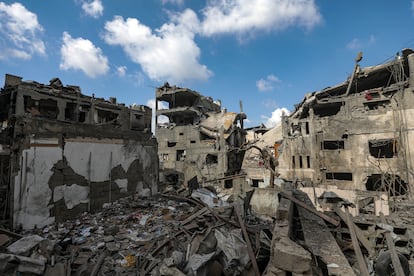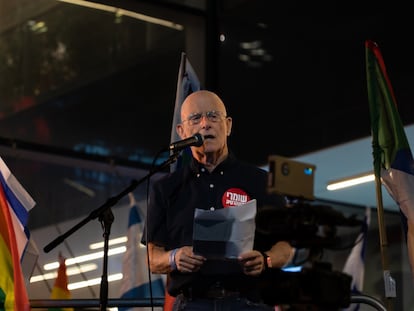Israel-Hamas conflict: What is happening and what does Israel intend to do in Gaza?
The invasion announced by the Israeli army to ‘completely destroy’ Hamas will involve urban warfare that favors the Islamist militia and will entail large numbers of casualties

The 2.3 million inhabitants of the Gaza Strip are facing the launch of an imminent ground invasion announced by the Israeli army after Israel on Friday ordered the population in the north of the Palestinian enclave to evacuate to the south. The U.N. has confirmed that at least 600,000 Palestinians, out of a population of 1.1 million in northern Gaza, have already fled their homes to seek refuge and escape an assault that has been preceded by heavy aerial bombardment after the fundamentalist group Hamas attacked Israeli territory on October 7, killing 1,400 people and kidnapping around 200. Meanwhile, the only border crossing not controlled by Israel — the Rafah crossing, which connects Gaza with Egypt — remains closed to refugees and humanitarian aid. More than 2,800 Gazans have so far been killed in the shelling, according to the Gaza Ministry of Health.
What is happening in Gaza?
Israel on Friday ordered all residents of northern Gaza to move south of the Wadi Gaza River, ahead of a military operation “by land, sea and air” was announced by an Israeli army spokesman. At least 600,000 Palestinians have since left their homes in the northern part of the enclave, according to the U.N., whose secretary-general, António Guterres, has described the exodus as “extremely dangerous and, in some cases, simply impossible.” Hamas, for its part, has urged residents to stay in their homes and dismissed the Israeli order as “propaganda aimed at confusing citizens and breaking internal Palestinian cohesion.”
Since October 7, when Hamas — considered a terrorist organization by the EU and the U.S. — attacked southern Israel, the government of Benjamin Netanyahu has imposed a “complete siege” on Gaza. The blockade of the enclave includes cutting off supplies of water, electricity, food and fuel.
The siege, the massive displacement order and the more than 6,000 bombs dropped by Israel since the day of the Hamas attack, have turned Gaza into a trap. The enclave’s two main border crossings — Erez, under Israeli control, and Rafah, managed by Egypt — are closed to people and humanitarian aid. Hundreds of thousands of Palestinians are sheltering in Gaza’s 92 U.N. schools and in hospitals that are on the verge of running out of fuel to power the generators that provide electricity to keep incubators and ventilators running.
What does Israel intend to do in Gaza?
Israel has announced its intention to “completely destroy the government and military capacity of Hamas and the terrorist organizations” and has deployed a large number of troops on Gaza’s borders. In addition to the Israeli regular army, which is estimated at 160,000 troops, the Israeli government has mobilized 300,000 reservists.
Israel has conducted a massive bombardment of Gaza, especially the outskirts of Gaza City, in what is interpreted as an attempt to pave the way for the entry of its forces. Images show entire streets razed to the ground. The order to the population to move south indicates that the Israeli army has no intention of occupying all of Gaza. Nor does anything indicate that Israel intends to hold the territory, which it unilaterally abandoned in 2005, under indefinite control: a new occupation would be costly in economic, political, and diplomatic terms and in Israeli lives. Gideon Saar, a minister without portfolio in the national unity government formed on October 11, has already announced that Gaza “must be smaller at the end of the war,” alluding to the establishment of a security zone between the Palestinian enclave and Israel to prevent attacks like the one on October 7.
What are the difficulties of a ground invasion?
A ground operation in Gaza is very complicated. As demonstrated in cities such as Aleppo, Syria, urban warfare allows an initially weaker opponent — such as the armed wing of Hamas, the Izz ad-Din al-Qassam Brigades — to defend itself in the short and medium term, even against a very powerful conventional force such as the Israeli army.
An abundance of hiding places and parapets, which provide cover for snipers and ambushes, the effectiveness of guerrilla warfare in streets and buildings or rubble, the greater knowledge of the terrain and the network of 500 kilometers of subterranean tunnels under Hamas control make Israel aware that this ground operation will probably entail a large number of casualties. The use of weapons such as heavy artillery against urban environments densely populated by civilians signifies another red line that Israel is already crossing, according to human rights organizations: international humanitarian law prevents the targeting of civilians.
Hamas militiamen are in high spirits after their unexpected success on October 7. One of the central aspects of their ideology is also the cult of martyrdom; they have carried out several suicide attacks in the past. An adversary who is not afraid to die is considerably more dangerous.
What are Israel’s chances of wiping out Hamas?
Israel has already announced the deaths of some Hamas military commanders in the bombings in Gaza. However, wiping out the organization’s leadership and ending its dominance over the territory is a complicated task. Israel has shown no signs of wanting to occupy Gaza, so it is foreseeable that the group’s leaders will take refuge in the south, where the Israeli army has ordered the civilian population to settle. Although on a lesser scale than in the past, Hamas continues to have popular support in Gaza and the West Bank. In May, the Islamic Bloc, Hamas’s student organization, swept the elections for student councils at major West Bank universities, now the only democratic institutions in Palestine. The group also has foreign support and funding from Qatar and Iran, and it is not out of the question that it will rebuild its leadership if its current members are killed.
What did Hamas intend with its attack?
With its offensive, the success of which surprised even its own leaders, Hamas probably intended not only to deal a severe blow to the security of the Israeli state and the confidence of its citizens in the government, but also to present itself to Palestinian public opinion as the dominant political actor, in contrast to the discredited Palestinian National Authority, which governs the West Bank, and which has proven helpless in the face of an Israeli occupation tolerated by the international community. The aggressive policy of expansion of Jewish settlements in the West Bank promoted by the Israeli government of Benjamin Netanyahu explains in large part why this year has been the deadliest in history for Palestinians living in this Israeli-occupied territory. In September, Save the Children put the number of children killed by Israeli forces so far this year at 38, the worst figure ever recorded.
Many analysts have speculated that Hamas, one of whose allies and financiers is Iran, may also have intended this attack to send a message to Saudi Arabia in order to derail the establishment of relations between the great Sunni power and Israel, which was almost being taken for granted. The capture of hostages as bargaining chips for the approximately 6,000 Palestinians held in Israeli jails was another of their motivations, as the militia has stated. Among these prisoners, several hundred are in administrative detention without charge or trial, and about 200 of them are minors. The issue of prisoners is one of the most sensitive for Palestinian society.
Sign up for our weekly newsletter to get more English-language news coverage from EL PAÍS USA Edition
Tu suscripción se está usando en otro dispositivo
¿Quieres añadir otro usuario a tu suscripción?
Si continúas leyendo en este dispositivo, no se podrá leer en el otro.
FlechaTu suscripción se está usando en otro dispositivo y solo puedes acceder a EL PAÍS desde un dispositivo a la vez.
Si quieres compartir tu cuenta, cambia tu suscripción a la modalidad Premium, así podrás añadir otro usuario. Cada uno accederá con su propia cuenta de email, lo que os permitirá personalizar vuestra experiencia en EL PAÍS.
¿Tienes una suscripción de empresa? Accede aquí para contratar más cuentas.
En el caso de no saber quién está usando tu cuenta, te recomendamos cambiar tu contraseña aquí.
Si decides continuar compartiendo tu cuenta, este mensaje se mostrará en tu dispositivo y en el de la otra persona que está usando tu cuenta de forma indefinida, afectando a tu experiencia de lectura. Puedes consultar aquí los términos y condiciones de la suscripción digital.
More information
Archived In
Últimas noticias
The digitalization of tourism: ‘They promise experiences and gave us the worst possible one’
Mexican peso defies uncertainty with forecasts of a new period of stability in 2026
Meghan Markle’s year of redemption: Numerous projects, some setbacks and a brand that is finally taking off
David King, chemist: ‘There are scientists studying how to cool the planet; nobody should stop these experiments from happening’
Most viewed
- Sinaloa Cartel war is taking its toll on Los Chapitos
- Oona Chaplin: ‘I told James Cameron that I was living in a treehouse and starting a permaculture project with a friend’
- Reinhard Genzel, Nobel laureate in physics: ‘One-minute videos will never give you the truth’
- Why the price of coffee has skyrocketed: from Brazilian plantations to specialty coffee houses
- Silver prices are going crazy: This is what’s fueling the rally










































